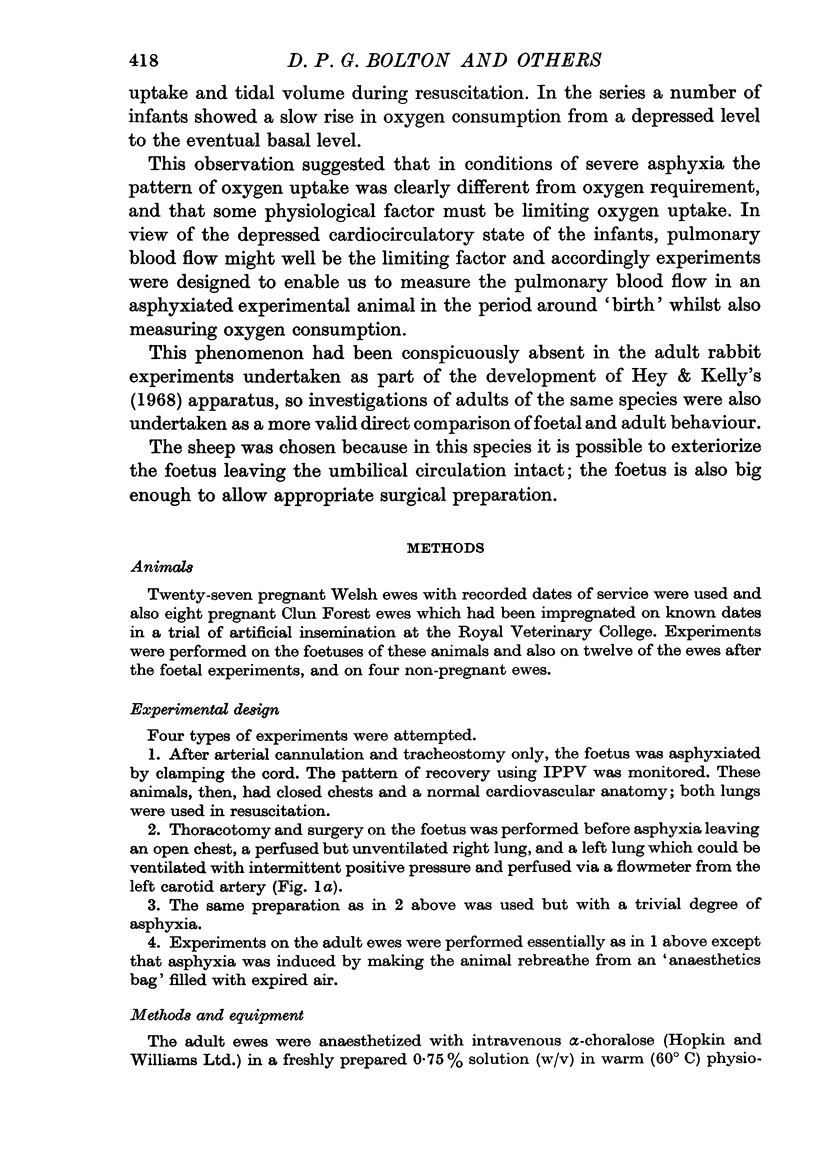Abstract
1. The foetuses of twenty-seven Welsh ewes and eight Clun Forest ewes were delivered by Caesarian section at an approximate gestational age of 140 days, maintaining the umbilical circulation. They were asphyxiated by clamping the umbilical cord, and resuscitated with IPPV. Oxygen consumption, heart rate, and blood pressures were recorded, and in one series of eight, blood flow through the left lung was recorded whilst IPPV was applied to this lung only.
2. The hypothesis that oxygen consumption is abnormally low during resuscitation of the new-born from extreme asphyxia because of limited blood flow, was supported.
3. Adult ewes were also asphyxiated and in a series of eight a quite different pattern of behaviour was observed, due to very rapid and complete recovery of the circulation.
4. Observations on the pulmonary vascular resistance suggest that complete vasomotor paralysis occurs during extreme asphyxia, so that resistance falls to a near-minimum level for unexpanded lung. Expansion of the lung produced a large fall in resistance which appeared to be due to the introduction of gas into the alveolar spaces, lessening the resistance to flow of the capillaries.
Full text
PDF

















Selected References
These references are in PubMed. This may not be the complete list of references from this article.
- BANISTER J., TORRANCE R. W. The effects of the tracheal pressure upon flow: pressure relations in the vascular bed of isolated lungs. Q J Exp Physiol Cogn Med Sci. 1960 Oct;45:352–367. doi: 10.1113/expphysiol.1960.sp001491. [DOI] [PubMed] [Google Scholar]
- Bolton D. P. Observations on pulmonary vascular resistance. J Physiol. 1969 Jun;202(2):96P–98P. [PubMed] [Google Scholar]
- CASSIN S., DAWES G. S., MOTT J. C., ROSS B. B., STRANG L. B. THE VASCULAR RESISTANCE OF THE FOETAL AND NEWLY VENTILATED LUNG OF THE LAMB. J Physiol. 1964 May;171:61–79. doi: 10.1113/jphysiol.1964.sp007361. [DOI] [PMC free article] [PubMed] [Google Scholar]
- Campbell A. G., Dawes G. S., Fishman A. P., Hyman A. I., Perks A. M. The release of a bradykinin-like pulmonary vasodilator substance in foetal and new-born lambs. J Physiol. 1968 Mar;195(1):83–96. doi: 10.1113/jphysiol.1968.sp008447. [DOI] [PMC free article] [PubMed] [Google Scholar]
- DAWES G. S., MOTT J. C. CHANGES IN O2 DISTRIBUTION AND CONSUMPTION IN FOETAL LAMBS WITH VARIATIONS IN UMBILICAL BLOOD FLOW. J Physiol. 1964 Apr;170:524–540. doi: 10.1113/jphysiol.1964.sp007347. [DOI] [PMC free article] [PubMed] [Google Scholar]
- DAWES G. S., MOTT J. C. The increase in oxygen consumption of the lamb after birth. J Physiol. 1959 May 19;146(2):295–315. doi: 10.1113/jphysiol.1959.sp006194. [DOI] [PMC free article] [PubMed] [Google Scholar]
- Godfrey S. Respiratory and cardiovascular changes during asphyxia and resuscitation of foetal and newborn rabbits. Q J Exp Physiol Cogn Med Sci. 1968 Apr;53(2):97–118. doi: 10.1113/expphysiol.1968.sp001965. [DOI] [PubMed] [Google Scholar]
- Hey E., Kelly J. Gaseous exchange during endotracheal ventilation for asphyxia at birth. J Obstet Gynaecol Br Commonw. 1968 Apr;75(4):414–424. doi: 10.1111/j.1471-0528.1968.tb00138.x. [DOI] [PubMed] [Google Scholar]


